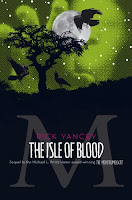In a lawless land, where life is cheap and survival is hard, Saba has been brought up in isolated Silverlake. She never sees theangers of the destructive society outside. When her twin brother is snatched by mysterious black-robed riders, she sets out on an epic quest to rescue him.
Post-apocalyptic and dystopian stories seem to be all the rage in YA literature at the moment, although neither are sub-genres that I have had a huge amount experience of reading. However, with a number arriving in the post over the past couple of months I decided that this summer would be a good time to see what is currently out there. I have read three new books that could fit into these categories recently, and each is very different from the others, either in setting or the nature of the apocalypse that befell society, and every one of them has been a hugely enjoyable read. This is a review for Blood Red Road by Moira Young, but watch this space for reviews for Six Days by Philip Webb and 20 Years Later by E.J. Newman.
Blood Red Road tells the story of Saba, a young teenage girl living in some remote dust-bowl of an area with her father, twin brother Lugh and younger sister Emmi. Saba feels incredibly close to Lugh, but her relationships with the rest of her family are fraught. Her father has been going increasingly potty since the death of Saba's mother, who died whilst giving birth to Emmi, and as such Saba has a great deal of resentment towards this younger sibling. The story is narrated in the first person by Saba, and initially I found it hard to get in to for two reasons. The first is that a good deal of Saba's narration is written in her dialect, exactly as it would be if she was dictating it out loud, and this really takes a great deal of getting used to. On its own, this would probably not cause too many problems, even for less confident teen readers, as it really does work and I found myself drawn into the story completely. However I feel that the issue was compounded by the complete lack of speech marks in the story, which means that every single line of dialogue blends in with the rest of the prose. Again, once I was used to it there was no problem, but this is where I think struggling readers may give up on the story.
As far as the story is concerned, I found myself constantly reminded of Mad Max: Beyond Thunderdome, and this feeling increased the further I got into the story. The post-apocalyptic desert setting is the first element that brought that Mel Gibson film to mind, but it is the lawless settlement of Hopetown, and some of the villainous fiends who live there, that really struck that chord of similarity in my mind. This is not a bad thing: although in my opinion Beyond Thunderdome is nowhere near as good a film as the previous two outings for Mad Max (too many pesky kids), I love the scenes set in Bartertown, and the fight scenes in the Thunderdome are fantastic.
To summarise very briefly, strange men appear on horseback one day, abduct Lugh and kill Saba's father in the process. She vows to herself that she will hunt them down and rescue her brother, and eventually ends up as a prisoner in completely misnamed Hopetown. Here she is forced to be a cage fighter, or face execution, for the entertainment of the rather nasty inhabitants of the town. At this point the story gets pretty violent, although the author always manages to hold off from describing some of the more potentially brutal scenes in full blood soaked detail. Instead of breaking her, Hopetown is the making of Saba, as she gives in to the rage whenever she enters the cage, and always leaves unbeaten, even if it means an opponent will face execution. She has one thing on her mind at all times, driving her on however bad things get: finding Lugh.
Saba is a great character: although initially I found it quite hard to like her, especially given the way she treats her younger sister, as the story progresses she grew and grew on me, and by the time she is cage fighting I was almost shouting out loud, egging her on to beat her latest opponent. This feeling of support for her increased even more throughout the second half of the book, but to tell you what happens there would be to spoil the story for you. In the course of her quest she meets a variety of other colourful characters, some of them good, some of them pretty damn nasty (Vicar Pinch and his mother are a delight to read).
It would be remiss of me to finish this review without mentioning Jack, and the relationship he builds with Saba. As with a great deal of YA novels featuring female main characters there is an element of romance to this story, as Saba meets and falls for the mysterious Jack. However, this is only a small part of the story, and there is more than enough action, adventure and violence to keep those boys who might normally avoid books with romantic elements thoroughly interested in the story. It certainly did not bother me at all, and I am now eagerly awaiting the sequel, due to be published sometime in 2012.
At nearly 500 pages this is quite a long book, and given the aforementioned issues regarding the phonetic narration and the lack of speech marks I would reluctantly suggest that this is not for less confident readers. Boys (and girls) of 13+ who are confident with their reading should however find this an exciting and rewarding read. My thanks go to the generous people at Scholastic for sending me a copy.























